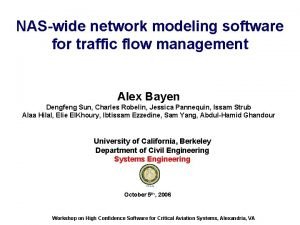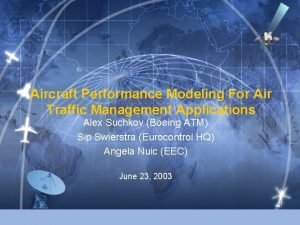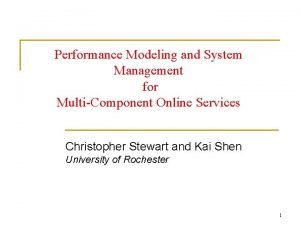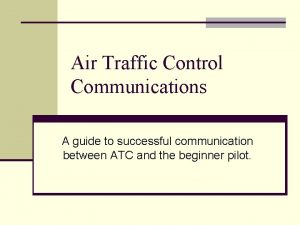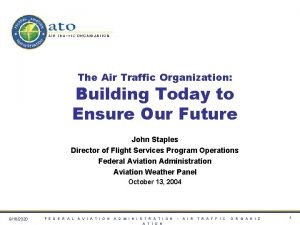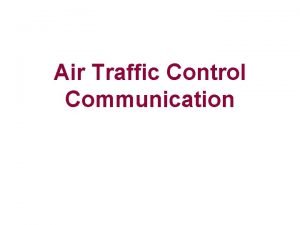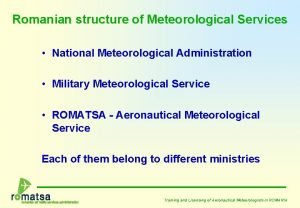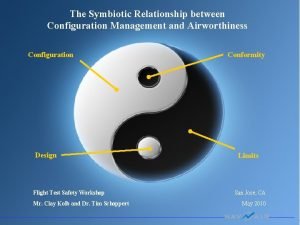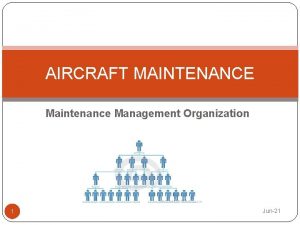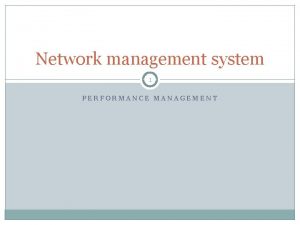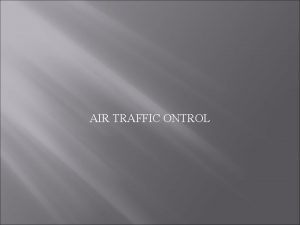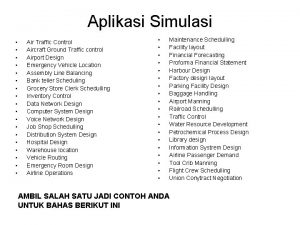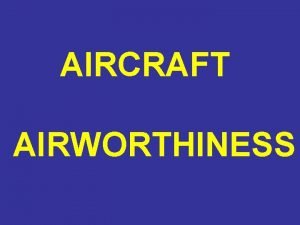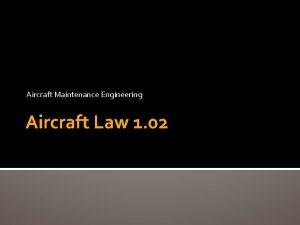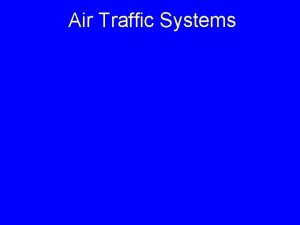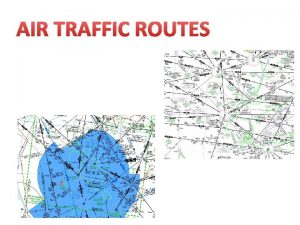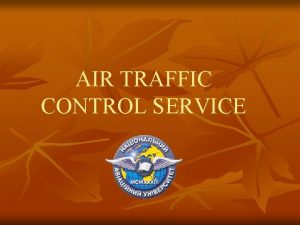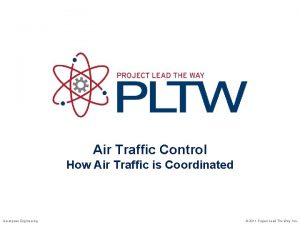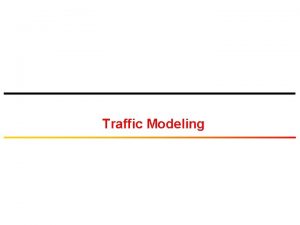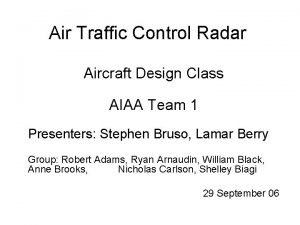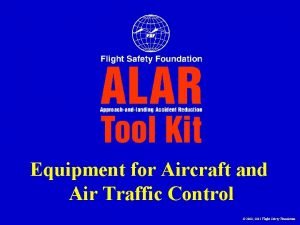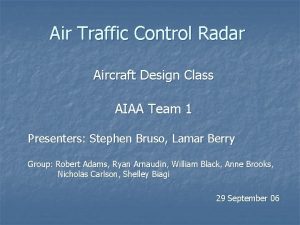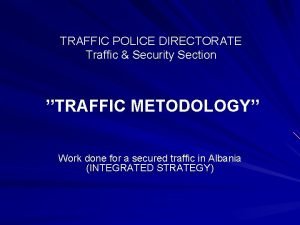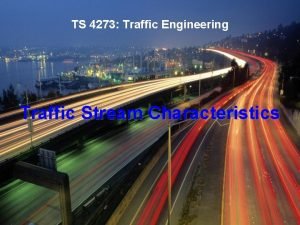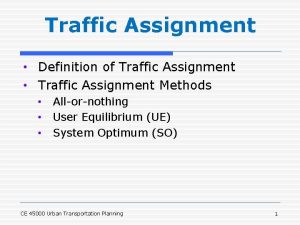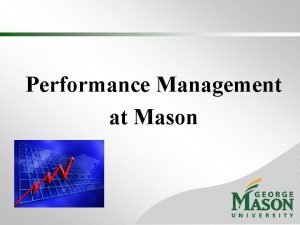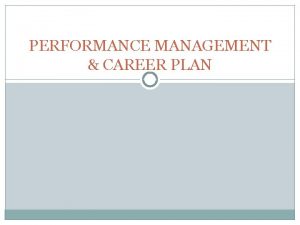Aircraft Performance Modeling For Air Traffic Management Applications






























- Slides: 30

Aircraft Performance Modeling For Air Traffic Management Applications Alex Suchkov (Boeing ATM) Sip Swierstra (Eurocontrol HQ) Angela Nuic (EEC) June 23, 2003

Outline • Introduction • Aircraft Performance Impact in ATM Applications • Aircraft Performance Models for ATM Applications • Source Data Requirements and Limitations • Steps Forward • Q&A 12/8/2020 2

Introduction RE: This paper “ … the reviewers did not feel that there was anything particularly new here for the ATM R&D community. The need, for example, for improved data from the aircraft is well known” RE: TAAM aircraft performance file “Aircraft performance redesign – that cat has been kicked enough” So, we have to bore you with this well known fact and to kick this poor cat even more to get finally started and move with this action… 12/8/2020 3

Aircraft Performance Impact IN ATM Applications 12/8/2020 4

Operational Variation Of Vertical Performance ROC and ROD Operational Variation Spread of vertical speeds observed for some 10, 000 flights with the mean, 5 th and 95 th percentiles depicted Magill, S. A. N. , January 1996, On the Vertical Speeds of Airways Traffic, Journal of Navigation, vol 49 no. 1 12/8/2020 5

TOW Variations • GTOW Uncertainties (even recorded by AOC could be 5, 0006, 000 lbs of the actual GTOW) – Fuel (e. g. fuel tankering) – Passengers – Cargo – OEW (crew members, equipment installation/removal, repaint) • Climb trajectory synthesis is extremely sensitive to errors in GTOW (especially at higher altitudes near TOC) 12/8/2020 6

TOW Variations (continued) • Example of 8, 000 flights (AOC data of two major airlines departing from DFW and DEN) – Same a/c type (also depending on its destination) can show a variation of – 27% to +56% of its mean GTOW – This could lead to variation of time to TOC (FL 310) from 390 sec to 2, 390 sec and path distance to TOC from 42 nmi to 270 nmi • Impact of GTOW uncertainty on TP – 900 ft/min-look-ahead-time – 0. 4 nm/min-look-ahead-time – Uncertainty in the vertical plane directly affects the uncertainty in the horizontal plane 12/8/2020 7

Engine Types ROC of one airframe with different engine configurations The difference in performance can be greater then between airframes (at least in the same transport category) 12/8/2020 8

Climb Speed Schedule Medium haul jet at the same GTOW Difference in CAS/Mach schedule may lead to 10 to 23 NM difference in distance to climb from 1, 500 ft to FL 300 12/8/2020 9

Impact On System Capacity • Study by Magill (Magill, S. A. N. , October 1997, Trajectory Predictability and Frequency of Conflict Avoidance Action, CEAS 10 th European Aerospace Conference, Amsterdam) – Simulations assumed a high quality of predicted trajectories based on an uncertainty in the horizontal plane speed of 0. 13 NM/minute-look-ahead-time and 5% uncertainty in the vertical speed – The requirement for the Confidence level was: at the maximum look-ahead time of 20 min, 95% of the conflicts must be detected – Compromise between the loss in ATM efficiency and false alert rate acceptable by the controllers 12/8/2020 10

Impact On System Capacity (continued) Look-Ahead Time (min) False-Alert Rate (% of true conflicts) 5 70 10 125 15 160 20 200 For trajectory predictors that provide less accurate performance data the situation is even significantly worse 12/8/2020 11

Aircraft Performance Data in Simulated and Operational Environment • Real and Fast Time Simulators (e. g. TAAM, AADS, TGF, TOPAZ) – Highly sophisticated and often very expensive tools are still lacking good aircraft performance data – Enormous amount of the performance data “tweaking” by multiple users creates a serious issue – Very simplistic look-up tables cover for a small portion of aircraft and the rest of the airframes are presented as equivalent types – Potentially can yield erroneous conclusions and move for operational implementation of sub-optimal or even nonoptimal alternative – Using aircraft performance as the “core”, additional set of inputs is required (often overlooked at present), namely airline operational procedures, SOPs, LOAs, etc. , adding further level of realism into the modeling process 12/8/2020 12

Aircraft Performance Data in Simulated and Operational Environment (continued) TAAM Aircraft Performance Example 12/8/2020 13

Aircraft Performance Data in Simulated and Operational Environment (continued) • Decision Support Tools (e. g. FDPS and FPP of CFMU (more strategic), LVNL AAA (tactical with longer time horizons), TP tools for CD&R (tactical)) – All on the previous page and in addition … – Efficiency and Safety can be compromised. Safety “buffers” can be pretty significant due to uncertainties (including aircraft performance) 12/8/2020 14

Aircraft Performance Models FOR ATM Applications 12/8/2020 15

Overview • Constant ROC, ROD and average cruise speed (e. g. ICAO documentation) • Look-Up tables (e. g. CFMU, TAAM) • Reduced order dynamics models (e. g. BADA) • 6 -DOF models (e. g. flight simulators) Bottom line is the balance between accuracy and simplicity 12/8/2020 16

Look-Up Tables • Oldest aircraft performance model developed for ATM applications • Kinematic model that is widely used by Flight Data Processing Systems and the Flight Profile Prediction function that drive Flow Management applications (e. g. CFMU tables provide for up to seven altitude bands, for each band – the average horizontal speed for climb, cruise and descent and the vertical speeds for climb and descent) • The flight profile calculation algorithms compute the horizontal flight path on the basis of the sequence of waypoints in the flight plan. Detailed SIDs and STARs are not considered. Thus there is a significant uncertainty in the path length at lower altitudes. For this application, the potential problems associated with this uncertainty are mitigated through a significantly lower estimate of horizontal and vertical speeds in the table 12/8/2020 17

Look-Up Tables (Continued) Table data for a typical short haul aircraft The thick line shows the tabular values and the selected altitude bands, the dotted line depicts the aircraft performance estimated by the aircraft performance program of the manufacturer for an average operational take-off mass 12/8/2020 18

Base of Aircraft Data (BADA) • Utilizes kinetic approach, i. e. based on independent modeling of thrust and drag • Aircraft performance database specifying operations performance model, airline procedures model and performance summary tables for various aircraft types • The information in BADA is designed for use in trajectory simulation and prediction algorithms within the domain of ATM • Currently covers (with directly modeled aircraft) nearly 90% European and 80% US air traffic • 87 directly modeled aircraft and 180 represented through equivalent types 12/8/2020 19

BADA (continued) • BADA is based on Total Energy Model (reduced point-mass model). TEM Equates the rate of work done by forces acting on the aircraft to the rate of increase in potential and kinetic energy • Reference aircraft performance and airline operating procedure data, required for modeling of an aircraft, is obtained from various aircraft documents provided by aircraft manufactures or aircraft operators 12/8/2020 20

BADA Continued • In order to obtain coefficients that can robustly represent the aircraft behavior over a variety of conditions a number of flight profiles is used: – Various weights (minimum, nominal and maximum) – Various climb speeds (low, nominal and high) – ISA and Non-ISA conditions • Not fully automated optimization process (to be addressed in the future enhancements) • A figure-of-merit is defined in BADA to measure the accuracy of a BADA aircraft model. A target value of 2. 0 % is set for nominal profiles, while maximum of 3. 0 % is generally acceptable for alternative speed, temperature and aircraft weight conditions 12/8/2020 21

Global Aircraft Modeling Environment (GAME) • Kinematic model based on purely parametric approach • Provides a direct model of the flight path characteristics of the aircraft without attempting to model the underlying physics • Highly automated environment • Presently comprises some 100 approximation functions • Total of 28 aircraft have been modeled 12/8/2020 22

GAME (continued) • The “primary” flight path characteristics like vertical speeds and fuel flow in the various phases of flight for different aircraft configurations are modeled and validated directly from the reference flight profile data provided by the aircraft manufacturers • The “secondary” flight path characteristics, like estimates for acceleration and deceleration, are computed from the “primary” approximations 12/8/2020 23

GAME (continued) Comparison between the GAME functions to compute the vertical speed for the flight modes climb at “Constant CAS” and “Constant Mach” and the manufacturers performance program. An example of the average climb speed errors for the complete practical range of take-off mass, climb speeds and temperature profiles from ISA-15 until ISA+15 for a typical short haul aircraft 12/8/2020 24

Source Data Requirements And Limitations 12/8/2020 25

Data Sources • Easy to access, but usually very limited: – Public Domain (e. g. , Jane’s, Aircraft Performance Textbooks) • Subject to legal and financial issues, but complete: – Aircraft Manufacturers (e. g. , Performance Software (INFLT, OPAL, PEPC), PEM) – Engine Manufacturers (e. g, EPM) – Airlines (e. g. , APM, FDR/FOQA data) – ATC Providers (e. g. , ETMS, ETFMS, SAR, ARTS data) 12/8/2020 26

Financial and Legal Issues • Costly production of performance manuals often requires aircraft and engine manufacturers to charge for these publications (up to 10, 000 $ and higher) • Archiving data (by airlines and ATC) requires media and personnel time • Historical misuse of performance data makes manufacturers more and more suspicious of R&D community • Potential legal actions (especially in the US) make release of the data by the airlines and ATC providers a very lengthy process (at times, just impossible) 12/8/2020 27

Steps Forward 12/8/2020 28

Steps Forward • Existing BADA collaboration between BATM, BCA, BRTC and EEC • Working to expand this collaboration both in technical scope (improvements in TMA, better drag polars, revision in drag and thrust algorithms etc. ) and in number of parties involved • Soliciting for additional requirements from the global ATM community (starting from the users of existing data, e. g. BADA) • Working with engine manufacturers (site reps) • Bringing other manufacturers (RJs, turboprop, piston, military) to increase coverage 12/8/2020 29

Steps Forward (continued) • Airlines • ATS Providers (DFS is already involved) • Model validation (in fast and real-time modeling environment and possibly in operational trials) • Automated modeling environment • Kinetic vs. Kinematic (solid validation and consensus including complimentary use (e. g. cruise, TMA, etc. ) • Close work with ATM Mod&Sim Tools Developers (e. g. existing MOA with Preston includes aircraft performance) 12/8/2020 30
 Helen erickson biography
Helen erickson biography Relational vs dimensional data modeling
Relational vs dimensional data modeling Flow network modeling software
Flow network modeling software Inbound traffic vs outbound traffic
Inbound traffic vs outbound traffic All traffic solutions
All traffic solutions Air higroskopis adalah
Air higroskopis adalah Bada aircraft performance summary tables
Bada aircraft performance summary tables Performance management vs performance appraisal
Performance management vs performance appraisal Performance levels
Performance levels Performance modeling
Performance modeling Apache traffic server load balancing
Apache traffic server load balancing Air traffic controller work hours
Air traffic controller work hours Air traffic control alphabet
Air traffic control alphabet Traffic organization service
Traffic organization service Air traffic communication
Air traffic communication Romanian air traffic services administration
Romanian air traffic services administration Aircraft configuration management
Aircraft configuration management Airline organization structure
Airline organization structure Performance testing mobile applications using loadrunner
Performance testing mobile applications using loadrunner Hplc principal
Hplc principal Network performance management system
Network performance management system Formuö
Formuö Typiska drag för en novell
Typiska drag för en novell Nationell inriktning för artificiell intelligens
Nationell inriktning för artificiell intelligens Vad står k.r.å.k.a.n för
Vad står k.r.å.k.a.n för Varför kallas perioden 1918-1939 för mellankrigstiden
Varför kallas perioden 1918-1939 för mellankrigstiden En lathund för arbete med kontinuitetshantering
En lathund för arbete med kontinuitetshantering Adressändring ideell förening
Adressändring ideell förening Tidbok för yrkesförare
Tidbok för yrkesförare Anatomi organ reproduksi
Anatomi organ reproduksi Förklara densitet för barn
Förklara densitet för barn


